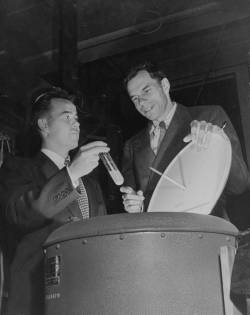Stanley G. Thompson was an American chemist responsible for the bismuth phosphate separation process used in the production of plutonium at the Hanford site during the Manhattan Project. After the war, Thompson also helped discover several transuranium elements.
Thompson received his B.A. from the University of California, Los Angeles, in 1934. Thompson began working for Standard Oil in California after his graduation, where he continued his friendship with Glenn Seaborg, whom he met his freshman year of high school. When Seaborg moved to the Chicago Met Lab in 1942, he asked Thompson to join him. While in Chicago, Thompson devised a chemical process to help separate plutonium from the other radioactive products created in the reactors. The bismuth phosphate separation process was employed at Hanford at an industrial scale, and Thompson moved to Washington to help oversee its implementation. While in Hanford, Thompson supervised the reactor’s first production of plutonium and its shipment to Los Alamos.
Thompson returned to Chicago in 1945, where shifted his focus to the discovery of transuranium elements. He moved to the Rad Lab in Berkeley in 1946 and completed his Ph.D. dissertation, titled “Nuclear and Chemical Properties of Americium and Curium,” in two years. He led the team that synthesized and identified berkelium and californium, elements 97 and 98. Thompson also led the teams that discovered the next three transuranic elements—einsteinium, fermium, and mendelevium.
Over the course of his career, Thompson did research in many other areas as well, including nuclear fission and heavy-ion reactions. He received two Guggenheim fellowships, and the American Chemical Society Award for Nuclear Applications in Chemistry in 1965.
Thompson died on July 16, 1976. After his death, Seaborg said, “His radiochemical research during World War II rivals in importance the isolation of radium by Pierre and Marie Curie, and his leadership in the discovery of five transuranium elements must rank as among the leading chemical accomplishments of his time.”





